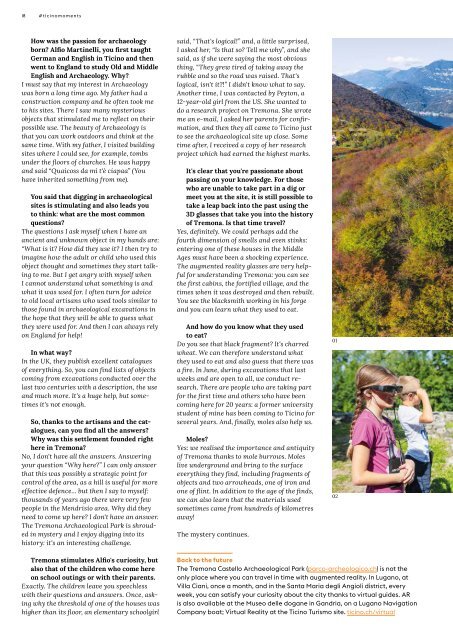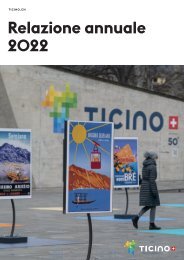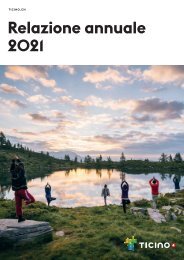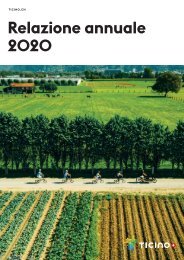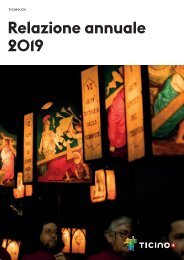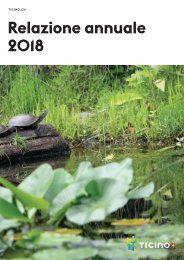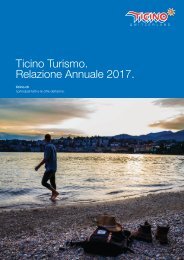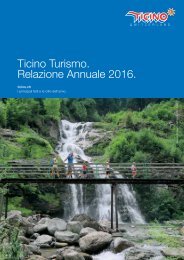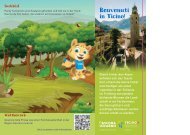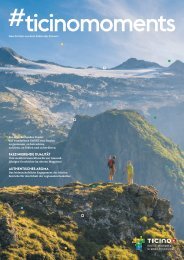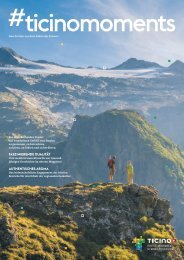#ticinomoments 2019
Create successful ePaper yourself
Turn your PDF publications into a flip-book with our unique Google optimized e-Paper software.
18 <strong>#ticinomoments</strong><br />
How was the passion for archaeology<br />
born? Alfio Martinelli, you first taught<br />
German and English in Ticino and then<br />
went to England to study Old and Middle<br />
English and Archaeology. Why?<br />
I must say that my interest in Archaeology<br />
was born a long time ago. My father had a<br />
construction company and he often took me<br />
to his sites. There I saw many mysterious<br />
objects that stimulated me to reflect on their<br />
possible use. The beauty of Archaeology is<br />
that you can work outdoors and think at the<br />
same time. With my father, I visited building<br />
sites where I could see, for example, tombs<br />
under the floors of churches. He was happy<br />
and said “Quaicoss da mì t'è ciapaa” (You<br />
have inherited something from me).<br />
You said that digging in archaeological<br />
sites is stimulating and also leads you<br />
to think: what are the most common<br />
questions?<br />
The questions I ask myself when I have an<br />
ancient and unknown object in my hands are:<br />
“What is it? How did they use it? I then try to<br />
imagine how the adult or child who used this<br />
object thought and sometimes they start talking<br />
to me. But I get angry with myself when<br />
I cannot understand what something is and<br />
what it was used for. I often turn for advice<br />
to old local artisans who used tools similar to<br />
those found in archaeological excavations in<br />
the hope that they will be able to guess what<br />
they were used for. And then I can always rely<br />
on England for help!<br />
In what way?<br />
In the UK, they publish excellent catalogues<br />
of everything. So, you can find lists of objects<br />
coming from excavations conducted over the<br />
last two centuries with a description, the use<br />
and much more. It's a huge help, but sometimes<br />
it's not enough.<br />
So, thanks to the artisans and the catalogues,<br />
can you find all the answers?<br />
Why was this settlement founded right<br />
here in Tremona?<br />
No, I don't have all the answers. Answering<br />
your question “Why here?” I can only answer<br />
that this was possibly a strategic point for<br />
control of the area, as a hill is useful for more<br />
effective defence… but then I say to myself:<br />
thousands of years ago there were very few<br />
people in the Mendrisio area. Why did they<br />
need to come up here? I don't have an answer.<br />
The Tremona Archaeological Park is shrouded<br />
in mystery and I enjoy digging into its<br />
history: it's an interesting challenge.<br />
said, “That's logical!” and, a little surprised,<br />
I asked her, “Is that so? Tell me why”, and she<br />
said, as if she were saying the most obvious<br />
thing, “They grew tired of taking away the<br />
rubble and so the road was raised. That's<br />
logical, isn't it?!” I didn't know what to say.<br />
Another time, I was contacted by Peyton, a<br />
12-year-old girl from the US. She wanted to<br />
do a research project on Tremona. She wrote<br />
me an e-mail, I asked her parents for confirmation,<br />
and then they all came to Ticino just<br />
to see the archaeological site up close. Some<br />
time after, I received a copy of her research<br />
project which had earned the highest marks.<br />
It's clear that you're passionate about<br />
passing on your knowledge. For those<br />
who are unable to take part in a dig or<br />
meet you at the site, it is still possible to<br />
take a leap back into the past using the<br />
3D glasses that take you into the history<br />
of Tremona. Is that time travel?<br />
Yes, definitely. We could perhaps add the<br />
fourth dimension of smells and even stinks:<br />
entering one of these houses in the Middle<br />
Ages must have been a shocking experience.<br />
The augmented reality glasses are very helpful<br />
for understanding Tremona: you can see<br />
the first cabins, the fortified village, and the<br />
times when it was destroyed and then rebuilt.<br />
You see the blacksmith working in his forge<br />
and you can learn what they used to eat.<br />
And how do you know what they used<br />
to eat?<br />
Do you see that black fragment? It's charred<br />
wheat. We can therefore understand what<br />
they used to eat and also guess that there was<br />
a fire. In June, during excavations that last<br />
weeks and are open to all, we conduct research.<br />
There are people who are taking part<br />
for the first time and others who have been<br />
coming here for 20 years: a former university<br />
student of mine has been coming to Ticino for<br />
several years. And, finally, moles also help us.<br />
Moles?<br />
Yes: we realised the importance and antiquity<br />
of Tremona thanks to mole burrows. Moles<br />
live underground and bring to the surface<br />
everything they find, including fragments of<br />
objects and two arrowheads, one of iron and<br />
one of flint. In addition to the age of the finds,<br />
we can also learn that the materials used<br />
sometimes came from hundreds of kilometres<br />
away!<br />
The mystery continues.<br />
01<br />
02<br />
Tremona stimulates Alfio's curiosity, but<br />
also that of the children who come here<br />
on school outings or with their parents.<br />
Exactly. The children leave you speechless<br />
with their questions and answers. Once, asking<br />
why the threshold of one of the houses was<br />
higher than its floor, an elementary schoolgirl<br />
Back to the future<br />
The Tremona Castello Archaeological Park (parco-archeologico.ch) is not the<br />
only place where you can travel in time with augmented reality. In Lugano, at<br />
Villa Ciani, once a month, and in the Santa Maria degli Angioli district, every<br />
week, you can satisfy your curiosity about the city thanks to virtual guides. AR<br />
is also available at the Museo delle dogane in Gandria, on a Lugano Navigation<br />
Company boat; Virtual Reality at the Ticino Turismo site. ticino.ch/virtual


